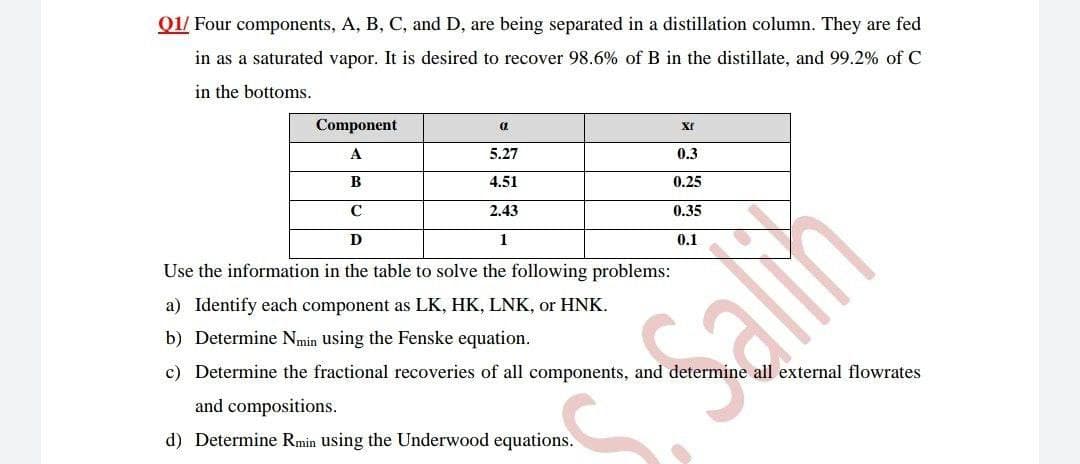Q1/ Four components, A, B, C, and D, are being separated in a distillation column. They are fed in as a saturated vapor. It is desired to recover 98.6% of B in the distillate, and 99.2% of C in the bottoms. Component Xf A 5.27 0.3 B 4.51 0.25 C 2.43 0.35 D 1 0.1 Use the information in the table to solve the following problems: a) Identify each component as LK, HK, LNK, or HNK. b) Determine Nmin using the Fenske equation. c) Determine the fractional recoveries of all components, and determine all external flowrates and compositions. d) Determine Rmin using the Underwood equations. unes.
Q1/ Four components, A, B, C, and D, are being separated in a distillation column. They are fed in as a saturated vapor. It is desired to recover 98.6% of B in the distillate, and 99.2% of C in the bottoms. Component Xf A 5.27 0.3 B 4.51 0.25 C 2.43 0.35 D 1 0.1 Use the information in the table to solve the following problems: a) Identify each component as LK, HK, LNK, or HNK. b) Determine Nmin using the Fenske equation. c) Determine the fractional recoveries of all components, and determine all external flowrates and compositions. d) Determine Rmin using the Underwood equations. unes.
Introduction to Chemical Engineering Thermodynamics
8th Edition
ISBN:9781259696527
Author:J.M. Smith Termodinamica en ingenieria quimica, Hendrick C Van Ness, Michael Abbott, Mark Swihart
Publisher:J.M. Smith Termodinamica en ingenieria quimica, Hendrick C Van Ness, Michael Abbott, Mark Swihart
Chapter1: Introduction
Section: Chapter Questions
Problem 1.1P
Related questions
Question
I need the answer as soon as possible

Transcribed Image Text:Q1/ Four components, A, B, C, and D, are being separated in a distillation column. They are fed
in as a saturated vapor. It is desired to recover 98.6% of B in the distillate, and 99.2% of C
in the bottoms.
Component
a
Xf
A
5.27
0.3
B
4.51
0.25
C
2.43
0.35
D
1
0.1
Use the information in the table to solve the following problems:
a) Identify each component as LK, HK, LNK, or HNK.
b) Determine Nmin using the Fenske equation.
c) Determine the fractional recoveries of all components, and determine all external flowrates
and compositions.
d) Determine Rmin using the Underwood equations.
Salin
Expert Solution
This question has been solved!
Explore an expertly crafted, step-by-step solution for a thorough understanding of key concepts.
This is a popular solution!
Trending now
This is a popular solution!
Step by step
Solved in 5 steps with 2 images

Recommended textbooks for you

Introduction to Chemical Engineering Thermodynami…
Chemical Engineering
ISBN:
9781259696527
Author:
J.M. Smith Termodinamica en ingenieria quimica, Hendrick C Van Ness, Michael Abbott, Mark Swihart
Publisher:
McGraw-Hill Education

Elementary Principles of Chemical Processes, Bind…
Chemical Engineering
ISBN:
9781118431221
Author:
Richard M. Felder, Ronald W. Rousseau, Lisa G. Bullard
Publisher:
WILEY

Elements of Chemical Reaction Engineering (5th Ed…
Chemical Engineering
ISBN:
9780133887518
Author:
H. Scott Fogler
Publisher:
Prentice Hall

Introduction to Chemical Engineering Thermodynami…
Chemical Engineering
ISBN:
9781259696527
Author:
J.M. Smith Termodinamica en ingenieria quimica, Hendrick C Van Ness, Michael Abbott, Mark Swihart
Publisher:
McGraw-Hill Education

Elementary Principles of Chemical Processes, Bind…
Chemical Engineering
ISBN:
9781118431221
Author:
Richard M. Felder, Ronald W. Rousseau, Lisa G. Bullard
Publisher:
WILEY

Elements of Chemical Reaction Engineering (5th Ed…
Chemical Engineering
ISBN:
9780133887518
Author:
H. Scott Fogler
Publisher:
Prentice Hall


Industrial Plastics: Theory and Applications
Chemical Engineering
ISBN:
9781285061238
Author:
Lokensgard, Erik
Publisher:
Delmar Cengage Learning

Unit Operations of Chemical Engineering
Chemical Engineering
ISBN:
9780072848236
Author:
Warren McCabe, Julian C. Smith, Peter Harriott
Publisher:
McGraw-Hill Companies, The